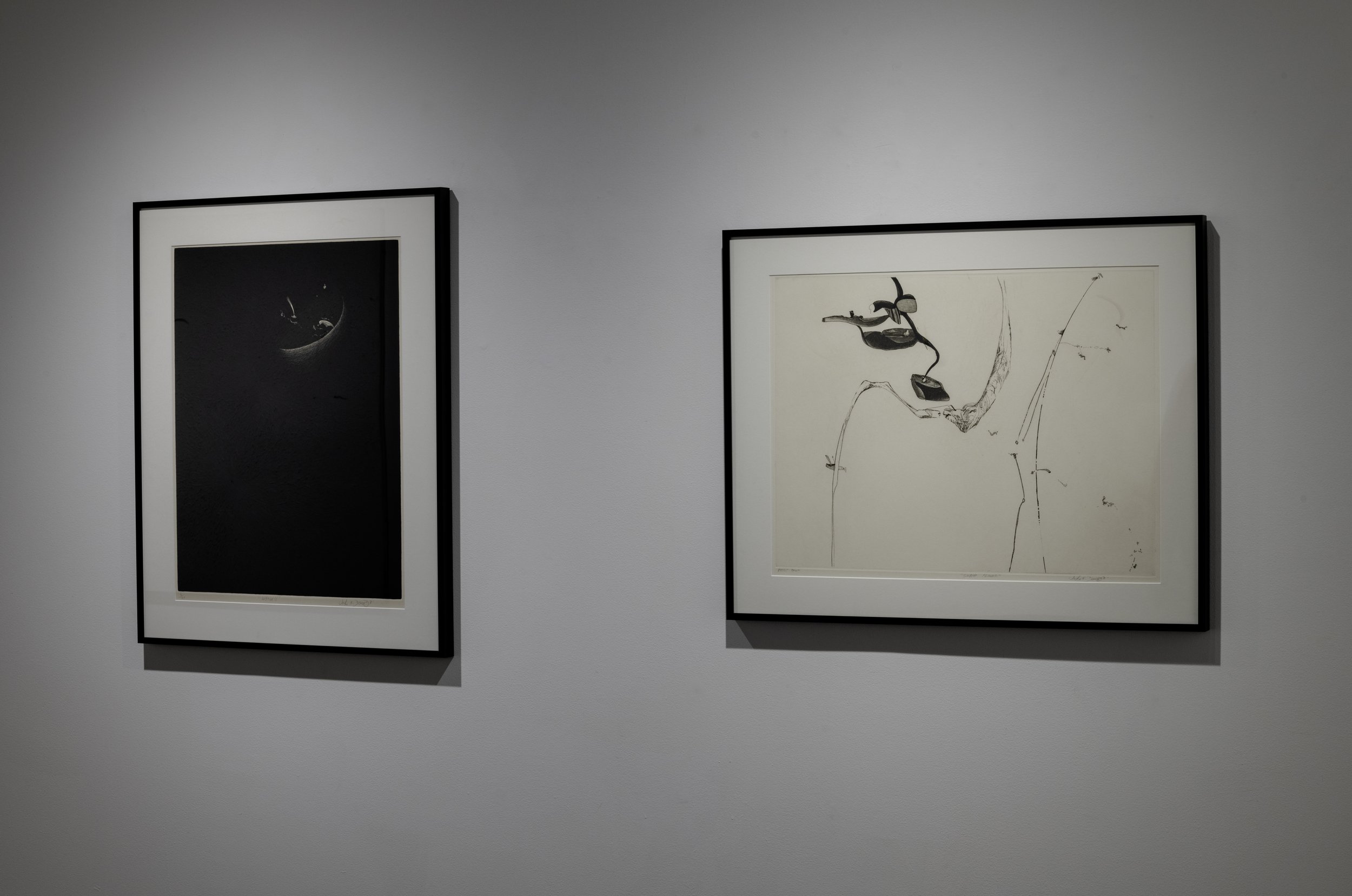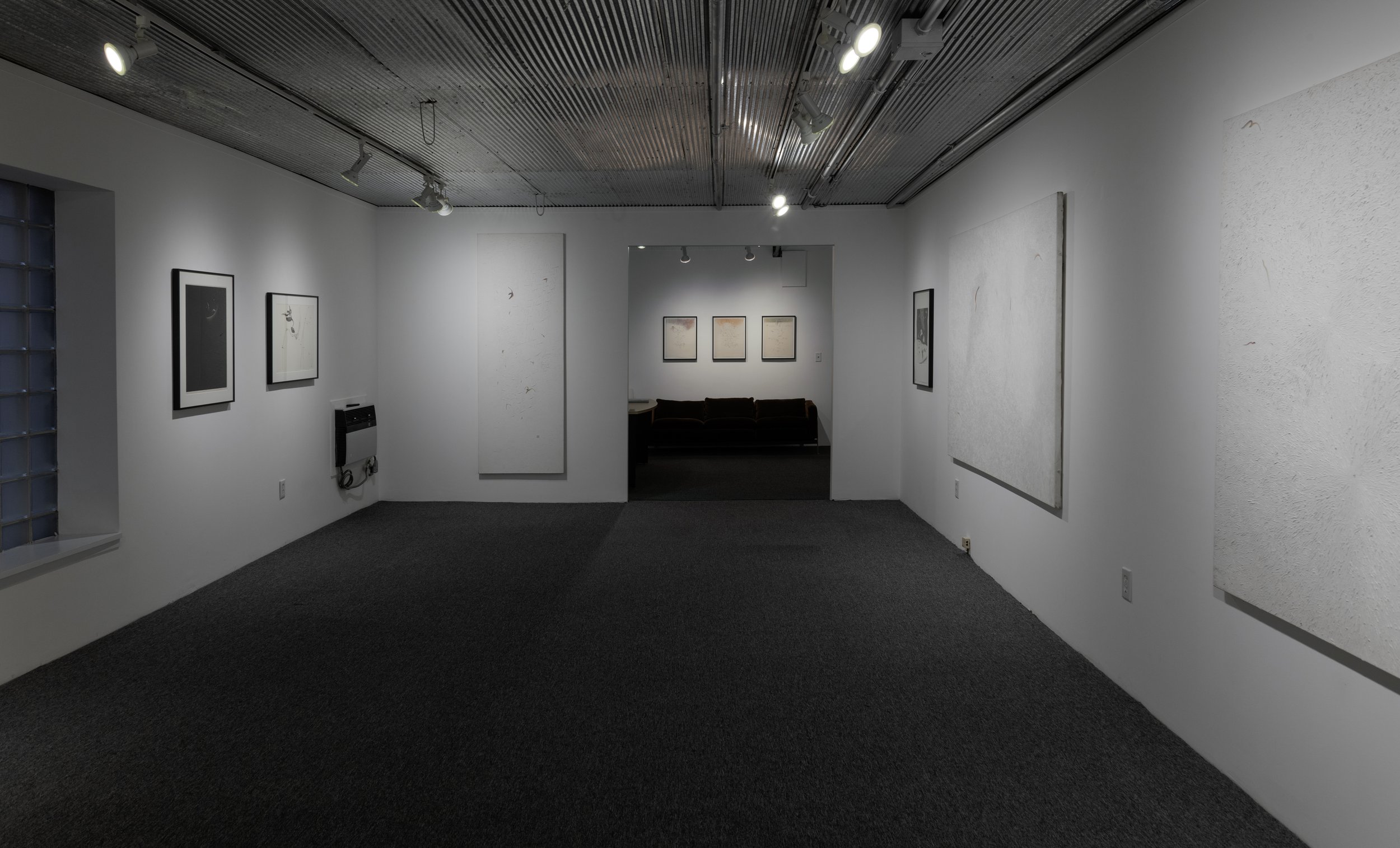John E. Dowell: Paintings and Aquatints
February 1 - April 26, 2024
John E. Dowell: Paintings and Aquatints presents selections from the “White Painting” series from 1976 - 1990 and several aquatints created between 1967 - 1986. His early practice was inspired by music and dance, particularly the compositions of John Cage and John Coltrane, and he is a self-taught jazz pianist. His painted gestures are non-objective. They leap throughout an open background, activating the blank space with linear yet improvisational marks, like a musical score. His techniques in painting are contrasted in his approach to printmaking. His aquatints, many of which are composed of black backdrops, resemble snapshots of graphic animations. In his words: “By 1972, I felt my visual work embodied order. My work then became the score, the structure, the set of relationships that could incorporate any number of systems for its audio-realization. The forms and their environment in my work are visual realizations of my ideas of sounds.”
“Whatever is said about John Dowell's art should sound alive, should handle Flash (I mean all the daring, show-off stuff) with dignity and delicacy, should handle its complexity and contradiction in a nice and easy almost nothing to it way. Not so easy. But John Dowell's art deserves words that would work this way. It's the way his art works. Sounds. Alive.” - Walter Hopps, National Collection of Fine Arts, Washington D.C., 1973
Biography
John E. Dowell (1941 - ) was born in Philadelphia and grew up in a housing project. As a child, he explored art with his brother by copying the work in Lone Ranger comics. He studied at the Tyler School of Art at Temple University, where he was mentored by ceramist Rudolf Staffel. And he mastered his printmaking skills at the Tamarind Institute in Los Angeles, CA, where he worked as a senior printer. His work is influenced by abstract expressionists Willem de Kooning, Philip Guston, and Jackson Pollock and jazz musicians such as Miles Davis, Archie Shepp, and Cecil Taylor.
He often focuses on abstract visual representations of poetry and music, notably jazz. While visiting Bahia, Brazil in 1988, Dowell explored interest in traditional African religions and began making works inspired by voodoo forces and spirits. Many know Dowell as a photographer—though he would aptly amend that statement to “an artist with a camera”—but over the course of his impressive artistic career, Dowell has explored a wide variety of mediums ranging from painting to ceramics to musical composition. Dowell’s expansive body of work, housed in his studio in North Philadelphia, is one of great dimension. Though diverse in medium, his works reflect a continuity of formal concerns and a unified goal: to provide the viewer with a transportive, real experience that “leads them to themselves.”
Dowell has been Professor Emeritus of Printmaking at the Tyler School of Art at Temple University since 1971. Dowell’s prints, paintings and photographs have been featured in more than fifty solo exhibitions and represented in the permanent collections of seventy museum and public collections. Among them are the Museum of Modern Art and the Metropolitan Museum of Art in New York City, the Museum of Fine Arts, Boston, the San Francisco Museum of Modern Art, and the Bibliothèque Nationale in Paris, France. Dowell’s photographs are in the Houston Museum of Fine Arts and have been added to his work in the collections of the Fogg Museum of Harvard University, the Museum of the Rhode Island School of Design and the Lehigh University Museum.
Move in Sequence, 1977, Acrylic on canvas, 59 7/8 x 83 5/8 inches
Score 1, Free Form for Ten, 1973 - 74, Etching and aquatint, Edition of XV, IV/XV, 29 7/8 x 22 1/8, paper, 30 7/8 x 24 1/4 inches, framed
Swamp Flower, 1967, Etching and aquatint, Edition of 20, Artist Proof, 22 3/4 x 28 3/4, paper, 24 1/4 x 30 inches, framed
Ornette, 1986, Acrylic on canvas, 84 x 30 inches
Sounds, 1967, Etching and Aquatint, Edition of 18, Artist Proof, 19 1/2 x 14 inches, paper, 21 3/4 x 16 1/4 inches, framed
Reverence of my Egun, 1989, Acrylic on canvas, 59 1/2 x 80 inches
Shepp’s Hambone, 1967, Etching and aquatint, Artist Proof, 27 3/4 x 19 1/2, paper, 30 x 21 3/4 inches, framed
Soul Coltrane, 1967, Etching and aquatint, Edition of 20, Artist Proof, 21 3/4 x 27 inches, paper, 21 1/4 x 30 inches, framed
To Dance Yesterday’s Dreams, 1977, Acrylic on canvas, 59 7/8 x 84 inches
Shape of Time, 1986, Acrylic on canvas, 84 x 30 inches
To Move with Tomorrow, 1978, Acrylic on canvas, 59 3/4 x 84 1/8 inches
Whew, 1968, Etching and aquatint, Edition of 20, 6/20, 30 x 22 1/4 inches, paper, 30 3/4 x 24 1/4 inches, framed
Coltrane Sonnet, from the "Visual Poems Portfolio", 1970 – 71, A group of eight lithographs in color and one unique ink drawing (You have to Love, to Sing), Edition of 20, 3/20, 20 x 15 inches, paper, 21 ¾ x 16 ¼ inches, each, framed
Drownin’ on Dry Land, from the "Visual Poems Portfolio", 1970 – 71, A group of eight lithographs in color and one unique ink drawing (You have to Love, to Sing), Edition of 20, 3/20, 20 x 15 inches, paper, 21 ¾ x 16 ¼ inches, each, framed
Just Heard Bessie, from the "Visual Poems Portfolio", 1970 – 71, A group of eight lithographs in color and one unique ink drawing (You have to Love, to Sing), Edition of 20, 3/20, 20 x 15 inches, paper, 21 ¾ x 16 ¼ inches, each, framed

























